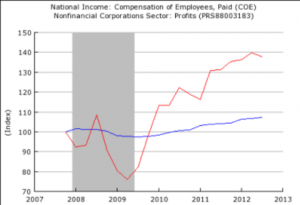Paul Krugman published an article today that consisted of 3 sentences and a chart entitled “No Trickle” that he presents as evidence that company profits do not trickle down to employees. However, he fails to examine the potential microeconomic reasons for the short-term data he presents. The chart he references is the following (pardon the blurriness):
The red line indicates profits and the blue line total workers’ compensation and is for the beginning of the financial crisis through sometime in late 2012. Yes, it does indicate that there is currently a gap between profits and workers’ compensation, but the question Krugman should be asking is: “Why?”. Of course to do so would require looking at the issue from the perspective of business owners (the microeconomic perspective), which is not something Krugman has ever been very good at. So what are some microeconomic reasons this gap exists?
1) High unemployment means labor is a buyer’s market. This is basic supply and demand. With unemployment rates high, companies do not have to compete for high quality labor, keeping labor rates relatively steady. As the unemployment rate begins to fall, the gap will decrease significantly. While this is a macro- rather than a microeconomic reason, it is still an important consideration for businesses.
2) Wage rates move closer to the long-run profit average than profit at a point-in-time. Even pulling 8 extreme data points from the above graph indicates the average index is approximately 127 making the compensation index at the last data point of approximately 109 much closer to average profits than the graph at that point-in-time indicates. You will also notice that employees were not asked to take the same 20 percent decrease in compensation that profits took in 2009. Steady compensation is a good thing. Wage increases also generally lag profit increases, as companies need to feel comfortable with long-term costs and economic factors before raising compensation.
3) Inflation concerns. Companies are holding onto cash for several reasons. One reason is concern that monetary policies conducted by the Fed during the recession will ultimately lead to inflation once the economy begins to heat up. This will mean higher labor costs and other factors of production that will require cash.
4) Other employee cost uncertainty. Companies look at employee compensation from the perspective of wages and benefits. Since Krugman describes the blue line as “total workers’ compensation” I will assume it includes benefits as well. The uncertainty of rising healthcare costs associated with full implementation of the Affordable Healthcare Act as well as unemployment insurance, social security, and Medicare/Medicaid taxes provide disincentives to increase base wages as overall employee costs are anticipated to rise in the coming years.
From both a macro and microeconomic perspective there is nothing surprising, or particularly alarming about the profit/compensation pattern presented in Krugman’s article.
Holly A. Bell is a business and economics professor in the University of Alaska system and an experienced author, analyst, manager, and blogger who lives in the Mat-Su Valley of Alaska. You can visit her website at www.professorhollybell.com or follow her on Twitter at @HollyBell8

